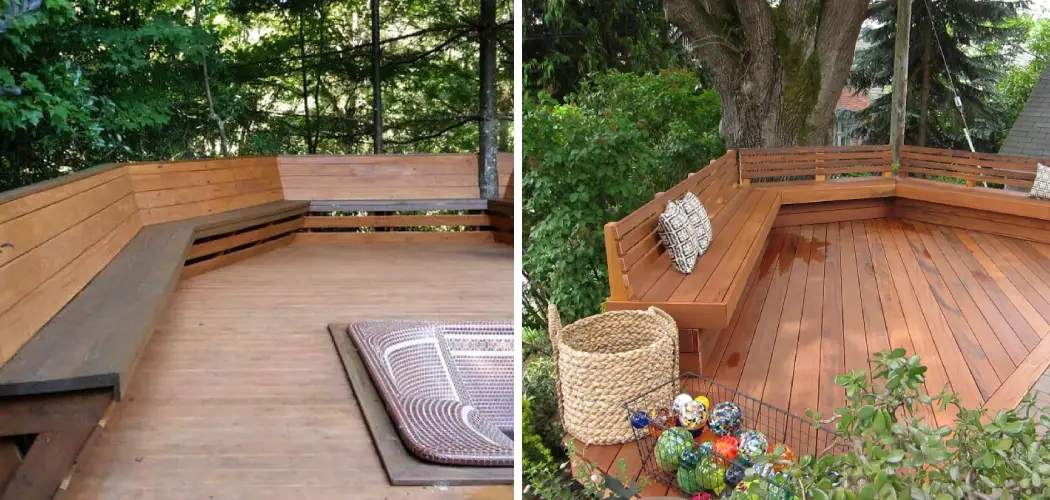When it comes to outdoor projects, building a deck with benches instead of railings is a popular option that provides lots of benefits. Not only does this type of construction give you more seating for your visitors, but it also adds visual appeal and style that can be unmatched by traditional decks with straight lines and railings.
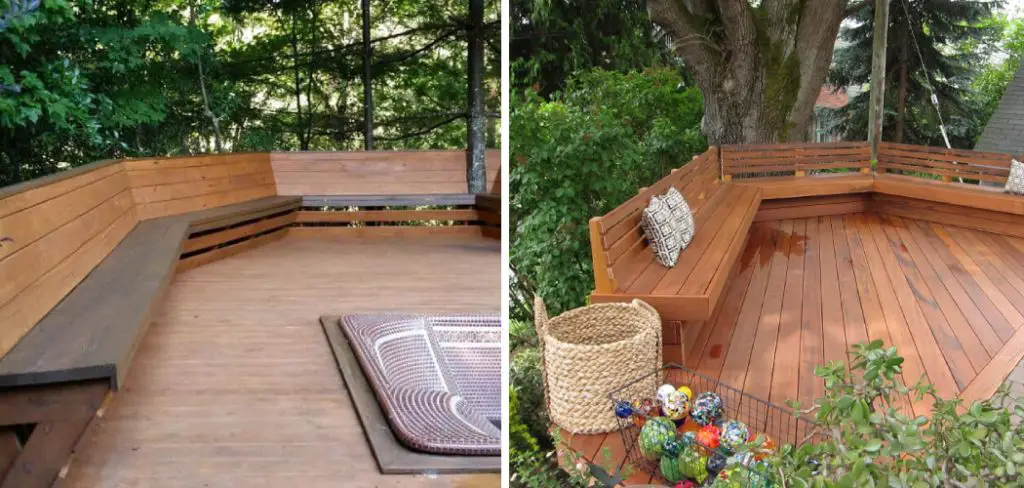
With the right supplies, tools, and knowledge, you’ll have your new deck built in no time! In this tutorial, we will discuss how to build a deck with benches instead of railings, along with the materials required and types of benches commonly used, as well as tips on how to ensure proper ventilation so you can enjoy your beautiful space safely and comfortably.
What Can I Use on My Deck Instead of Railing?
When designing a deck, the railing is often an afterthought — but it should be just as much of a priority as other aspects. Railing will provide safety and security to your deck, so even if you don’t want the traditional look of a railing, there are plenty of alternatives to choose from.
One popular option is to opt for benches instead of railings. Benches can add visual interest to your deck and provide extra seating without creating an obstruction. You can use built-in benches or install separate furniture pieces in lieu of railings. This means that you still get the same level of security as with traditional railings while also providing comfort and style.
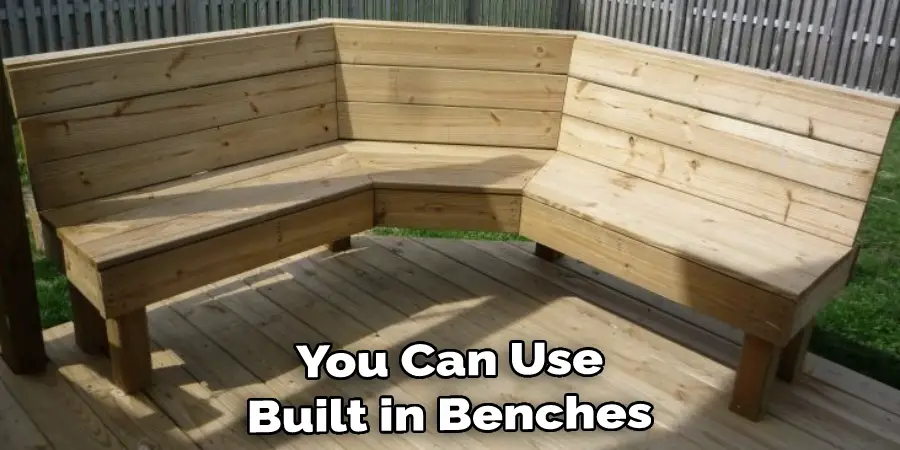
Another great option when it comes to railing alternatives is to opt for lattice or privacy panels. These panels provide a similar level of security while also increasing the visual appeal of your deck and providing more privacy if needed. You can even use plants such as climbing ivy to create a natural barrier along the edges of your deck.
10 Methods How to Build a Deck with Benches Instead of Railings
1. Design and Planning
Start by designing your deck with benches instead of traditional railings. Consider the desired size, shape, and layout of the deck, as well as the number and placement of benches. Take into account the overall aesthetic and functionality of the deck, ensuring that the benches blend seamlessly with the design.
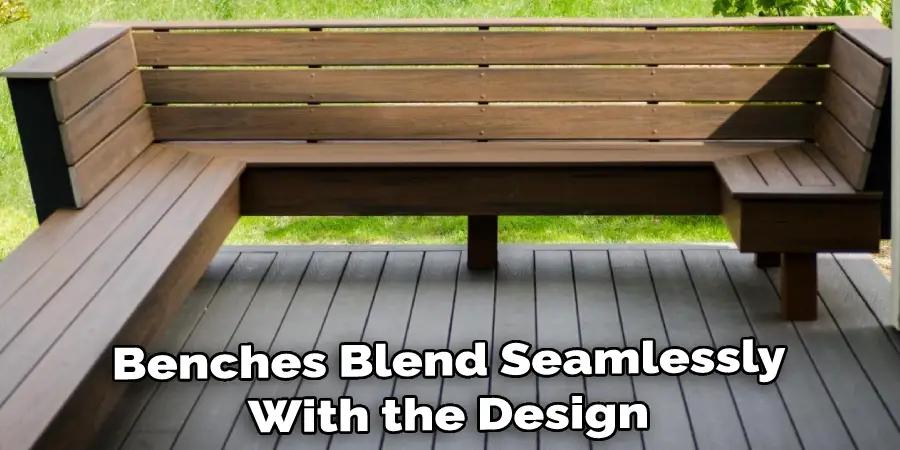
To make the process easier, use online tools to help you create a 2D or 3D design. When you’re satisfied with the design, create a detailed plan that includes measurements, materials list, and estimated costs. While the plan doesn’t need to be 100% accurate, it will provide a general guide for construction.
2. Assess Local Building Codes
Check your local building codes and regulations to ensure compliance with the guidelines for deck construction. Some jurisdictions may have specific requirements for deck railings or safety features.
Confirm that building a deck with benches instead of railings is permissible within your area. To complete this step, you may need to consult with a local building inspector. Although the local rules for decks vary, typically, a deck must have railings at least 36 inches high with balusters spaced no more than four inches apart.
3. Choose Bench Style and Materials
Select the style and materials for your deck benches. Determine whether you prefer built-in benches or freestanding options. Consider materials that are suitable for outdoor use, such as pressure-treated lumber, cedar, or composite decking.

Take into account durability, maintenance requirements, and aesthetic appeal when making your choices. Make sure the style of the bench complements the overall design of your deck.
4. Plan Bench Placement
Decide where to position the benches on your deck. Consider factors such as the deck’s layout, traffic flow, and desired seating areas. Ensure that the benches are strategically placed to maximize comfort and functionality while allowing sufficient space for movement and other deck activities.
If the benches are too close together, you may have difficulty accessing them or even walking around. To best accommodate the shape and size of your deck, you may want to consider building a couple of benches in different sizes.
5. Prepare the Deck Frame
Prepare the deck frame by ensuring it is level and structurally sound. Make any necessary repairs or modifications to the existing frame. Ensure that the deck joists are properly spaced to support the weight of the benches and provide adequate stability.
While deck benches, instead of railings, maybe slightly less sturdy, they can still safely support the weight of people and furniture. If necessary, use additional bracing and supports to ensure the benches are secure. Although it is important to ensure a stable and safe deck frame, the structure should also be aesthetically pleasing. A well-built deck frame will complete the look of the deck.
6. Construct Bench Supports
Build the bench supports using sturdy materials, such as pressure-treated lumber or metal brackets. Attach the supports to the deck frame, ensuring they are securely fastened and level. Consider using diagonal bracing for added stability, especially for longer bench spans. Place the supports at even intervals to ensure a uniform and aesthetically pleasing look.
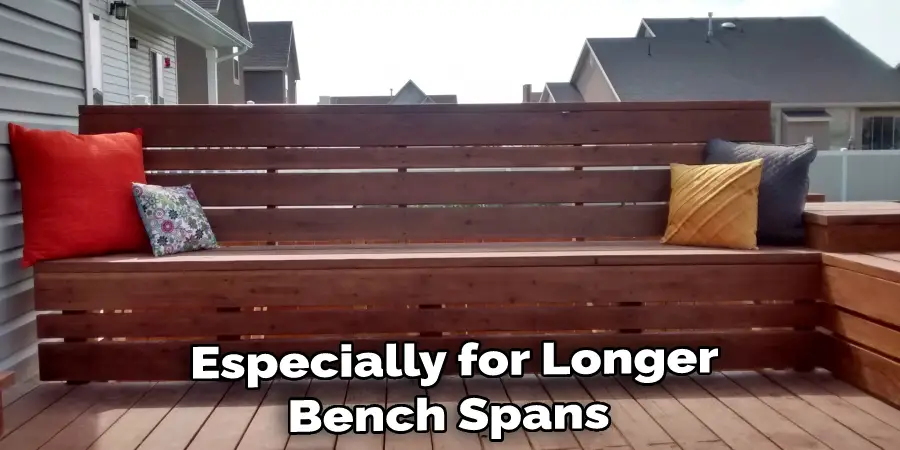
Try to make the distance between each support at least 12 inches to provide enough space for comfortable seating. Once you’ve installed the supports, you can begin constructing the benches.
7. Build Bench Seat and Backrest
Construct the bench seat and backrest using the chosen materials. Cut and assemble the bench components according to your design specifications. Ensure the seat height and backrest angle provide comfortable seating.
Use appropriate fasteners and techniques to securely join the bench pieces together. When attaching the seat to the frame, use lag screws long enough to penetrate at least 3 inches into the center of a joist. Try to maintain a space between the seat boards for neat appearance.
8. Install Bench Supports and Backrest
Attach the bench supports to the deck frame, ensuring they align with the designated bench placement. Secure the bench seat and backrest to the supports, making sure they are level and stable. Use appropriate screws or bolts to fasten the bench components securely in place.
Although the preferred material for outdoor benches is pressure-treated wood, you can also use composite materials such as plastic lumber. If using a composite material, ensure that the structural supports are also made of composite material to ensure that the deck frame and bench components will not corrode.
9. Finishing Touches
Add finishing touches to the benches to enhance their appearance and durability. Sand the bench surfaces to remove any rough edges or splinters. Apply a protective finish, such as stain or sealant, to safeguard the benches against weathering and UV damage. Consider adding cushions or pillows for added comfort and style.
However, be sure to choose fabrics and materials that are designed for outdoor use. Finally, add some finishing touches with decorations, such as planters or hanging lights, to make the bench area an inviting outdoor space. With these steps and a bit of elbow grease, you can create beautiful benches for your deck that are sure to be enjoyed for years to come.
10. Regular Maintenance
Regularly maintain the deck and benches to ensure their longevity and safety. Inspect the benches for any signs of wear, loose fasteners, or damage. Clean the bench surfaces regularly using a mild detergent and water. Address any issues promptly to prevent further deterioration and ensure the benches remain safe and functional.
Some Common Mistakes When Building A Deck with Benches Instead of Railings
1. Failing to Plan for Weight:
Benches can add a lot of weight to your deck and should be taken into consideration when planning your design. It is important to make sure the structural framing of your deck can support the added weight from benches and that the deck is properly fastened to your home or other structure.
2. Forgoing Protection from the Elements:
Since benches do not provide protection from the elements like a railing would, it is important to consider ways to protect your deck and benches from rain, snow, and wind. Some simple solutions include adding an awning over the deck or covering the benches with all-weather fabric.
3. Skipping the Finishing Touches:
When building a deck with benches instead of railings, it is important to finish the project off by adding details such as decorative accents and planters. These can help make the space look complete and add an extra level of style to your outdoor area.
Conclusion
Building a stunning outdoor area can give you the space to enjoy life with friends and family right in your backyard. By incorporating benches instead of railings into your deck design, you have the opportunity to add extra seating while creating an eye-catching display.
Plus, it’s much easier than you think! With these easy steps as your guide, using benches instead of railings is an inexpensive option for anyone who wants to start transforming their outdoor living space.
Give it a try you won’t be disappointed! So get creative and get building; explore all the possibilities of how to build a deck with benches instead of railings.
Learn about different materials, make smart use of space, and create something unique that will be sure to draw compliments from visitors. Let us know how your adaptive deck design turned out, and good luck!

